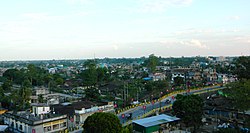Upper Assam division
Upper Assam | |
|---|---|
Division | |
 Dibrugarh is the largest city in Upper Assam division | |
 The five divisions of Assam | |
| Country | India |
| State | Assam |
| Largest city | Dibrugarh |
| Headquarters | Jorhat |
| Population | |
| • Total | 7.5 million |
| Time zone | UTC +05:30 (IST) |
Upper Assam is an
Consisting of 7 districts initially, the Upper – Assam division now contains 10 districts, that includes Biswanath, Jorhat, Dibrugarh, Dhemaji, Golaghat, Charaideo, Lakhimpur, Majuli, Sivasagar, and Tinsukia. While Charaideo and Majuli are the newest districts that were raised to district status in 2016,[1][2] Golaghat and Tinsukia are the biggest districts in terms square kilometre area in the region, raised to the district status in the years of 1987 and 1989 respectively.[3][4]
Dibrugarh,1 Golaghat2 and Jorhat3 are also the oldest recognised and constantly inhabited urban centres (municipal areas) in the region based on the earliest years of formation of the civic bodies, constituted before the Indian independence of 1947.[5]
An extended list of Upper – Assam region also includes the districts of Sonitpur, Karbi Anglong & Nagaon. The region is the most productive part of the state of Assam, which is rich in natural resources like coal, oil and natural gas as well as tea plantations.
History
Medieval
Chutia Kingdom
The medieval
Ahom Kingdom
The
Demographics
The Upper Assam division, comprising 24 percent of Assam's population at 7.56 million, predominantly adheres to Hinduism, with Islam being the second most practiced religion, embraced by over 80 percent of its people. More than 60 percent of the people speak Assamese with a sizeable Bengali and Hindi minority. The major communities of Upper assam are
Gallery
-
Dibrugarh
Night view of Dibrugarh -
Jorhat
Evening view of Jorhat -
Golaghat
Skyline of Golaghat Central (west) -
Tinsukia
Evening view of G. N. B. Road, Tinsukia
Notes
Notes
- ^ "Preparations afoot for inauguration of Charaideo district at Sonari, The Eastern Today". ET Correspondent. 10 February 2016.
- ^ "Assam: Majuli becomes 1st river island district of India". Hindustan Times. Guwahati. 27 June 2016. Retrieved 28 June 2016.
- ^ Law, Gwillim (2011-09-25). "Districts of India". Statoids. Retrieved 2011-10-11.
- ^ "Various Districts in Assam".
- ^ Sharma, Anil Kumar (1 January 2007). "Quit India Movement In Assam". Mittal Publications. Retrieved 5 August 2016 – via Google Books.
- ^ "Dibrugarh Municipal Board".
- ^ "AGP lists civic poll candidates (Golaghat Municipal Board)". Archived from the original on June 30, 2015. Retrieved 5 August 2016.
- ^ "Jorhat Municipal Board(JBM), Jorhat, Assam". Archived from the original on 2016-03-27. Retrieved 2016-08-05.
References
- Shakespear, Leslie (1914). History of Upper Assam, Upper Burmah and Northeast Frontier. Cambridge University Press.
- Gogoi, Padmeswar (1956). The political expansion of the Mao Shans.




